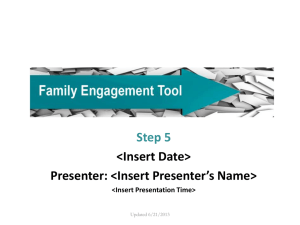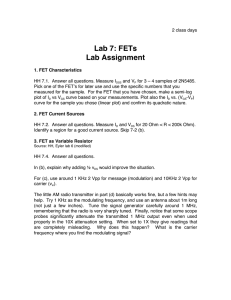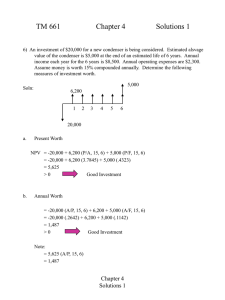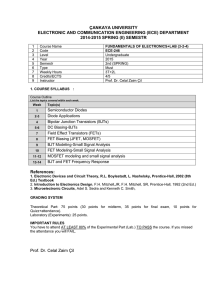AN-667 APPLICATION NOTE
advertisement
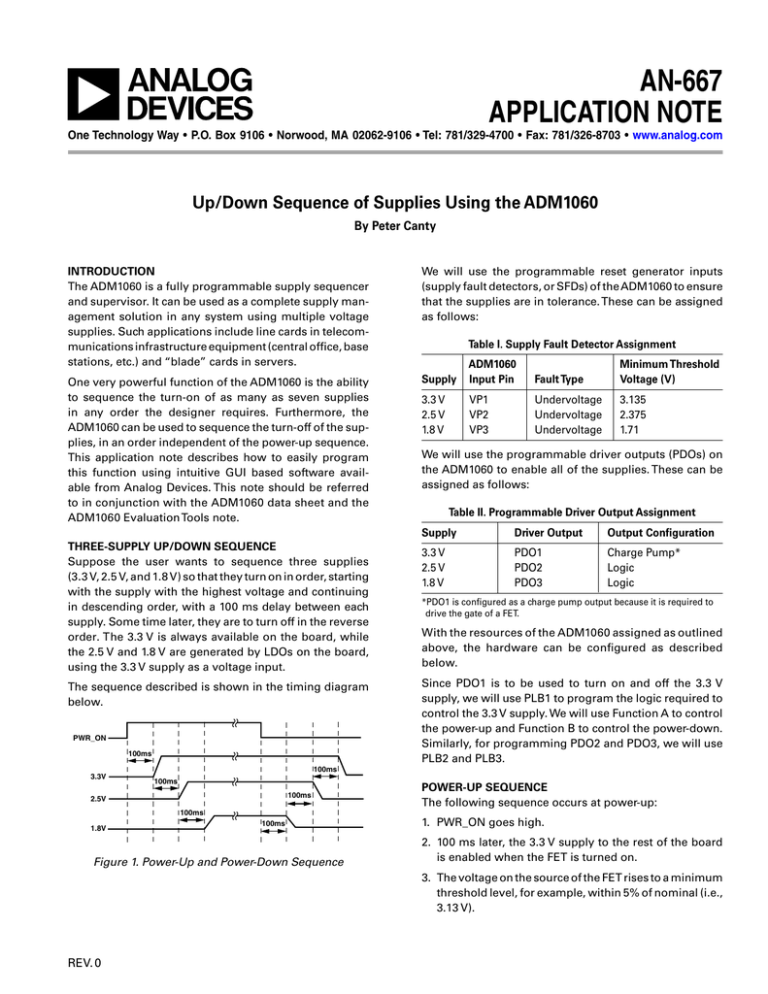
AN-667 APPLICATION NOTE One Technology Way • P.O. Box 9106 • Norwood, MA 02062-9106 • Tel: 781/329-4700 • Fax: 781/326-8703 • www.analog.com Up/Down Sequence of Supplies Using the ADM1060 By Peter Canty INTRODUCTION The ADM1060 is a fully programmable supply sequencer and supervisor. It can be used as a complete supply management solution in any system using multiple voltage supplies. Such applications include line cards in telecommunications infrastructure equipment (central office, base stations, etc.) and “blade” cards in servers. We will use the programmable reset generator inputs (supply fault detectors, or SFDs) of the ADM1060 to ensure that the supplies are in tolerance. These can be assigned as follows: One very powerful function of the ADM1060 is the ability to sequence the turn-on of as many as seven supplies in any order the designer requires. Furthermore, the ADM1060 can be used to sequence the turn-off of the supplies, in an order independent of the power-up sequence. This application note describes how to easily program this function using intuitive GUI based software available from Analog Devices. This note should be referred to in conjunction with the ADM1060 data sheet and the ADM1060 Evaluation Tools note. Supply ADM1060 Input Pin Fault Type Minimum Threshold Voltage (V) 3.3 V 2.5 V 1.8 V VP1 VP2 VP3 Undervoltage Undervoltage Undervoltage 3.135 2.375 1.71 THREE-SUPPLY UP/DOWN SEQUENCE Suppose the user wants to sequence three supplies (3.3 V, 2.5 V, and 1.8 V) so that they turn on in order, starting with the supply with the highest voltage and continuing in descending order, with a 100 ms delay between each supply. Some time later, they are to turn off in the reverse order. The 3.3 V is always available on the board, while the 2.5 V and 1.8 V are generated by LDOs on the board, using the 3.3 V supply as a voltage input. The sequence described is shown in the timing diagram below. ������ ����� ���� ����� ����� ����� ���� ����� ���� ����� Figure 1. Power-Up and Power-Down Sequence Table I. Supply Fault Detector Assignment We will use the programmable driver outputs (PDOs) on the ADM1060 to enable all of the supplies. These can be assigned as follows: Table II. Programmable Driver Output Assignment Supply Driver Output Output Configuration 3.3 V 2.5 V 1.8 V PDO1 PDO2 PDO3 Charge Pump* Logic Logic *PDO1 is configured as a charge pump output because it is required to drive the gate of a FET. With the resources of the ADM1060 assigned as outlined above, the hardware can be configured as described below. Since PDO1 is to be used to turn on and off the 3.3 V supply, we will use PLB1 to program the logic required to control the 3.3 V supply. We will use Function A to control the power-up and Function B to control the power-down. Similarly, for programming PDO2 and PDO3, we will use PLB2 and PLB3. POWER-UP SEQUENCE The following sequence occurs at power-up: 1. PWR_ON goes high. 2. 100 ms later, the 3.3 V supply to the rest of the board is enabled when the FET is turned on. 3. The voltage on the source of the FET rises to a minimum threshold level, for example, within 5% of nominal (i.e., 3.13 V). REV. 0 AN-667 3.3VIN 2.5V LDO 2.5V ENABLE 1.8V LDO 1.8V ENABLE ADM1060 VP1 VP2 VP3 VP4 PLB PDB SUPPLY FAULT DETECTORS (SFDs) 2.5V ENABLE 1.8V ENABLE SEQUENCING LOGIC PWR_ON OUTPUT DRIVERS (PODs) GPI1 GENERAL PURPOSE INPUTS (GPIs) PLB PDB 1.8V 2.5V 3.3V Figure 2. Sequencing of Three Supplies, Controlled by the ADM1060 4. 100 ms after the threshold voltage is reached, the 2.5 V LDO is enabled. When PWR_ON goes low, the 2.5 V and 3.3 V supplies must stay on. If just the function shown in Figure 3 were used, all the supplies would turn off once PWR_ON—and therefore GPI1—went low. We need to make the control of 2.5 V_EN and 3.3 V_FET_GATE dependent on a different set of conditions. To achieve this we will use the B function. We therefore need to switch control of the outputs from Function A to Function B. The easiest way to achieve this is using the GPI1 signal; when this is high (i.e., when power is on), Function A is in control; when GPI1 is low (i.e., we want the system to power down), Function B is in control. We therefore make Function B dependent on GPI1, which is high, when GPI1 is low. 5. The 2.5 V LDO output rises to a minimum threshold level, again say, within 5% of nominal (i.e., 2.375 V). 6. 100 ms after the 2.5 V supply reaches its minimum threshold, the 1.8 V LDO is enabled. The power-up sequence logic is shown in Figure 3. 3.3V_OK PWR_ON FET_SOURCE 2.5V_OK VP1 GPI1 PLB1_A PLB1 VP4 PLB2_A GPI1 PLB2 GPI1 PLB3_A VP2 PDB1 FET_GATE +100ms PDB2 2.5V_EN +100ms PDB3 The power-down sequence logic is shown in Figure 4. 1.8V_EN PWR_ON GPI1 PLB3_A PDB3 1.8V_EN +100ms +100ms PLB3 Figure 3. Logic Diagram for Three-Supply Power-Up Sequence GPI1 PLB2_B POWER-DOWN SEQUENCE The following sequence occurs at power-down: PDB2 2.5V_EN +100ms PLB2 GPI1 PLB1_B PDB1 3.3V_FET_GATE +100ms 1. PWR_ON goes low. Figure 4. Logic Diagram for Three-Supply Power-Down Sequence 2. 100 ms later, the 1.8 V supply is disabled. 3. 100 ms after the 1.8 V supply drops below its minimum threshold (say 5% below nominal, or 1.71 V), the 2.5 V supply is disabled. 4. 100 ms after the 2.5 V supply drops below 2.375 V, the 3.3 V supply is disconnected from the board when the FET is turned off. –2– REV. 0 AN-667 The setup required for the PDOs and the PLBs controlling them for each supply is shown in Figures 7–9. PROGRAMMING THE ADM1060 An example of how the SFD is programmed is shown below. All of the SFDs are programmed in a similar manner. Figure 7. Programming Power-Up and Power-Down Sequence for 3.3 V Supply Figure 5. Programming the Supply Fault Detectors The setup required for the PWR_ON signal (GPI1) is shown in Figure 6. Figure 8. Programming Power-Up and Power-Down Sequence for 2.5 V Supply Figure 6. Programming the PWR_ON Signal Input REV. 0 –3– AN-667 CONCLUSION The ADM1060, combined with its software, is a very powerful sequencing management solution. The ADM1060 can be used to control the sequence of multiple supplies as they power up and power down.The key to programming a power-down sequence, which is independent of the powerup sequence, is to use Function B in the programmable logic block. A single signal can be used to switch control from Function A to Function B. Figure 9. Programming Power-Up and Power-Down Sequence for 1.8 V Supply © 2003 Analog Devices, Inc. All rights reserved. Trademarks and registered trademarks are the property of their respective owners. –4– REV. 0 E04283–0–10/03(0) For greater detail on how to program the ADM1060, refer to the ADM1060 Evaluation Tools note.
